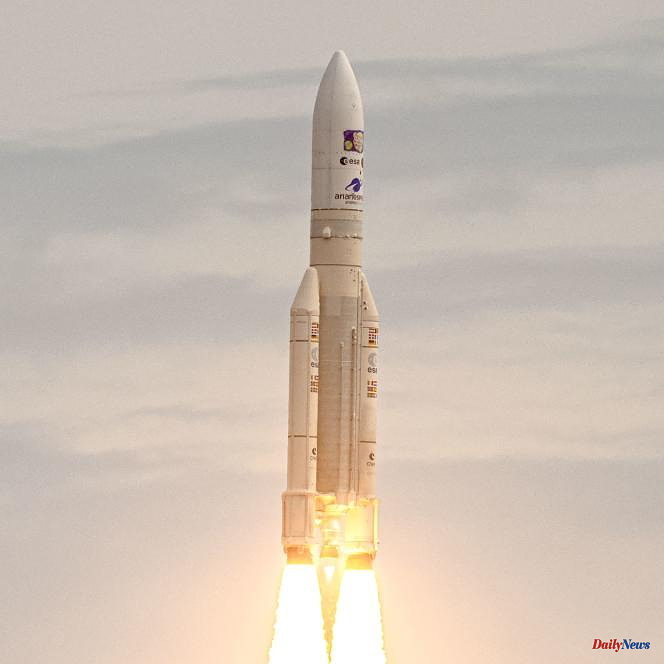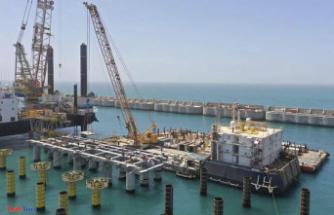The flagship mission of the European Space Agency (ESA), Juice (acronym for Jupiter Icy Moons explorer, "the icy moons explorer of Jupiter") took off from Kourou, French Guiana, aboard a rocket Ariane-5, Friday April 14. This is the first mission to target the giant planet since the US Juno mission, launched in 011.
His departure, originally scheduled for Thursday, had been postponed due to bad weather conditions. Unlike conventional launches which have a certain margin to take off, the launch window of the Juice probe is close to one second, due to the particular orbit which is targeted.
"The trajectory is nominal", that is to say in line with what was planned, said Friday, shortly after takeoff, the director of operations from the Jupiter control room of the Guiana Space Center, where the emotion was palpable.
The probe separated from its launcher twenty-eight minutes after takeoff, at an altitude of 1,500 kilometers to begin its long cruise for Jupiter, the largest planet in the Solar System, about 628 million kilometers from Earth. The Ariane-5 mission “is a success,” said Stéphane Israël, president of Arianespace.
"One of the most complex craft ever sent"
Designed by Airbus, Juice carries ten scientific instruments (camera, spectrometer, radar, altimeter, magnetometer, etc.), protected from extreme temperatures by a multi-layer insulation cover. The probe is also equipped with huge solar panels of 85 m2 – the equivalent of a basketball court – to supply it with energy, in an environment where the sunlight is 25 times weaker than on Earth. "It is one of the most complex spacecraft ever sent to the outer Solar System," explained ESA Director General Josef Aschbacher.
Its arrival in the vicinity of the giant planet is scheduled for July 2031. Before that, the probe will have to go through complex maneuvers of gravitational assistance, consisting in using the attraction force of other planets, to use them as catapult. A flyby of Venus in 2025, then again of Earth in 2029, will allow it to gain momentum towards its destination, the moons of Jupiter, discovered by the Italian Galileo at the beginning of the 17th century: Io the volcanic and his three companions frozen, Europe, Ganymede and Callisto.
In search of liquid water
Jupiter passing in front of its satellite Ganymede, photographed by the Hubble telescope, in 2008.
The Jovian system has "all the makings of a mini solar system," said Carole Mundell, science director for ESA. Its exploration "will make it possible to study how our solar system works, how the planets form".
Juice's main quest is to find not life directly, but environments for it to appear. If the gaseous planet Jupiter is uninhabitable, its moons Europa and Ganymede would be ideal candidates: under their icy surface, they harbor oceans of liquid water, believed to be the main ingredient for the emergence of life.
For more than three years, which will represent the first phase of her mission, Juice will carry out thirty-five flybys of the three satellites – two for Europa, twelve for Ganymede and twenty-one for Callisto – which she will inspect using her ten implements.
In 2034, it should be placed in orbit around Ganymede, the largest natural satellite in the Solar System (2,634 kilometers in radius) of a size comparable to the planet Mercury. It is also the only moon to have its own magnetic field protecting it from dangerous solar radiation, like the Earth.
"The Decade Mission"
Ganymede, the Jupiter satellite that the Juice probe will explore, seen from a NASA telescope in 2000.
Previous space missions have suggested the presence, between two thick crusts of ice, of a gigantic ocean, "several tens of kilometers, much deeper than the Earth's oceans", insisted Josef Aschbacher.
One of the questions is whether this liquid water interacts with the surface to be able to absorb its components. Such a reaction would allow the appearance of nutrients, one of the conditions for the development of an ecosystem conducive to life.
At a total cost of 1.6 billion euros, Juice is the first European mission to explore a planet in the outer solar system, beyond Mars and the Kuiper belt. "It's the mission of a decade," concluded Josef Aschbacher.
NASA, for its part, is preparing the departure of the Europa Clipper probe, whose trip is scheduled for the end of 2024, with the Europe satellite as its destination. The American agency hopes to determine if, under the inhospitable surface of this icy moon, exist environments suitable for life.












